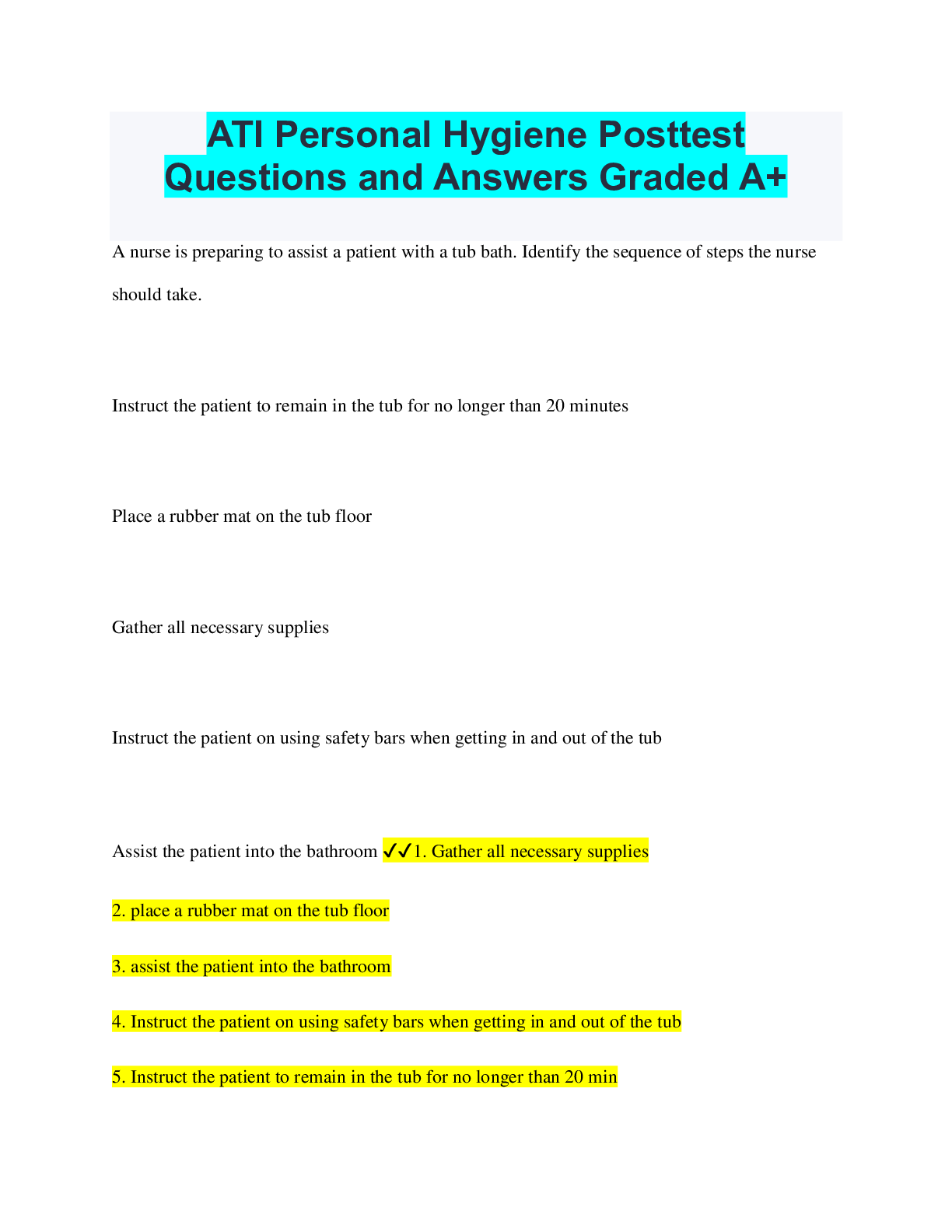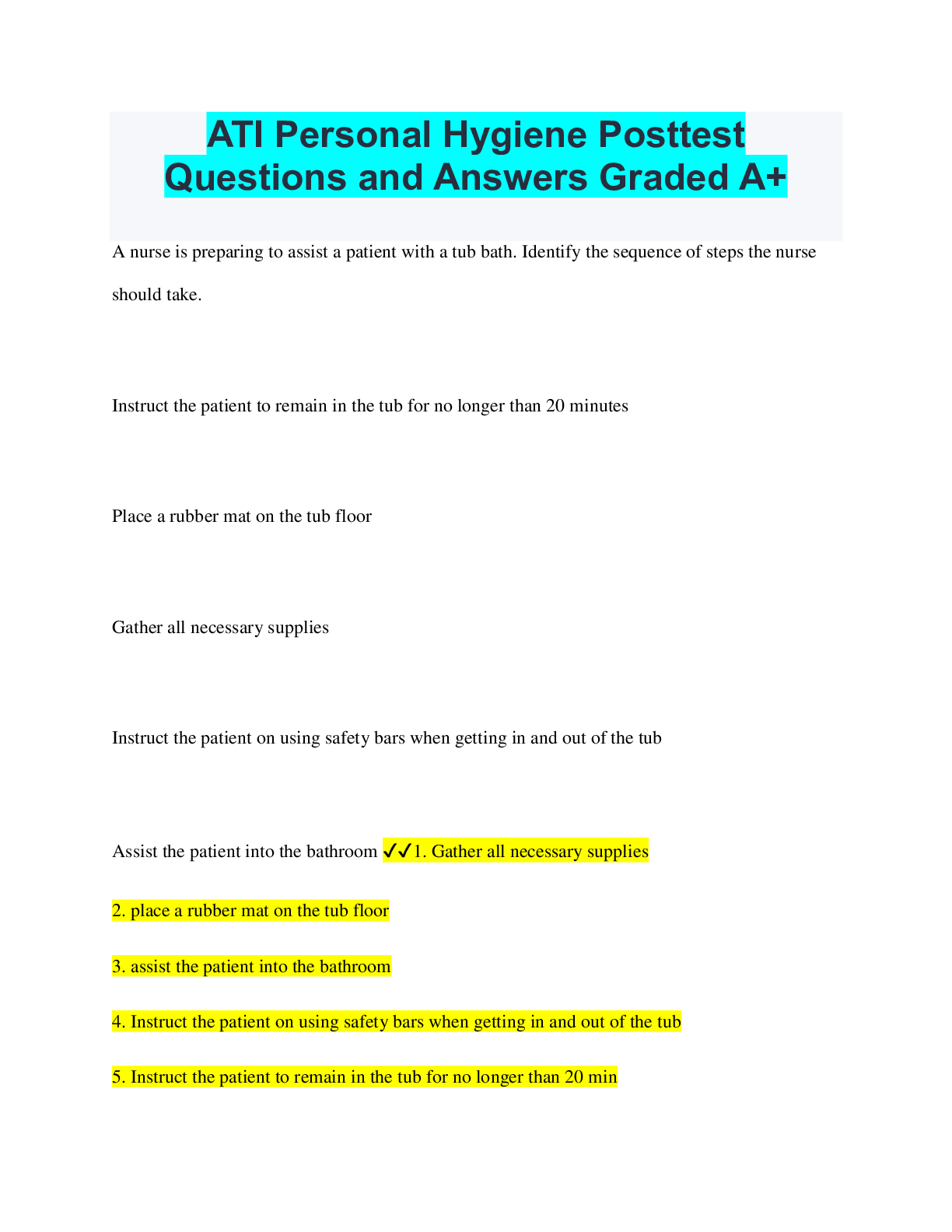Ihuman case study > EXAM REVIEW > NR 603 IHUMAN FUNDAMENTALS & DYSPENEA -JOSEPH CAMELLA) COMPLETED EXAM 2024 (All)
NR 603 IHUMAN FUNDAMENTALS & DYSPENEA -JOSEPH CAMELLA) COMPLETED EXAM 2024
Document Content and Description Below
1. What are the main components of the IHUMAN PATIENT system and what are their functions? (2 points) - The IHUMAN PATIENT system consists of a computer-based simulation platform, a patient avatar,... a virtual health record, and a clinical reasoning tool. The simulation platform allows students to interact with realistic patient scenarios, assess the patient's condition, order tests, prescribe treatments, and document their findings. The patient avatar is a digital representation of the patient that responds to the student's actions and provides feedback. The virtual health record contains the patient's medical history, vital signs, lab results, imaging studies, and other relevant information. The clinical reasoning tool helps students to develop their critical thinking and decision-making skills by providing guidance, hints, feedback, and rationales. (2 points) 2. What are the benefits of using the IHUMAN PATIENT system for nursing education? (2 points) - The IHUMAN PATIENT system provides several benefits for nursing education, such as: - Enhancing student engagement and motivation by creating realistic and immersive learning experiences. (0.5 point) - Promoting active learning and self-directed learning by allowing students to explore different scenarios and outcomes. (0.5 point) - Developing clinical competence and confidence by exposing students to various patient conditions and situations that they may encounter in practice. (0.5 point) - Improving clinical judgment and reasoning by providing feedback and rationales for each step of the nursing process. (0.5 point) 3. How can you access the IHUMAN PATIENT system and what are the technical requirements? (2 points) - To access the IHUMAN PATIENT system, you need to have an account on the i-Human website (https://www.i-human.com/) and log in with your username and password. You also need to have a stable internet connection and a compatible web browser (such as Chrome, Firefox, Safari, or Edge). The IHUMAN PATIENT system works on both desktop and mobile devices, but it is recommended to use a larger screen for optimal viewing. You may also need to enable pop-ups, cookies, and JavaScript in your browser settings. (2 points) 4. How can you select a patient case from the IHUMAN PATIENT library and what are the different types of cases available? (2 points) - To select a patient case from the IHUMAN PATIENT library, you need to click on the "Cases" tab on the top menu bar of the i-Human website. You will see a list of available cases that you can filter by category, difficulty level, specialty, or keyword. You can also search for a specific case by typing its name or ID in the search box. Once you find a case that you want to work on, you can click on its name or image to open it. (1 point) - There are different types of cases available in the IHUMAN PATIENT library, such as: - Symptom-based cases: These cases present patients with common or uncommon symptoms that require differential diagnosis and management. (0.5 point) - Diagnosis-based cases: These cases present patients with confirmed diagnoses that requirefurther evaluation and treatment. (0.5 point) 5. What are the steps involved in completing a patient case in the IHUMAN PATIENT system and what are the scoring criteria? (2 points) - The steps involved in completing a patient case in the IHUMAN PATIENT system are: - Reviewing the case overview: This step provides a brief introduction to the case, including the patient's name, age, gender, chief complaint, history of present illness, past medical history, family history, social history, medications, allergies, and learning objectives. You can also view the grading rubric for the case and access additional resources such as textbooks or websites. (0.5 point) - Performing a patient interview: This step allows you to ask questions to the patient avatar using natural language or selecting from a list of predefined questions. You can also use non-verbal communication skills such as nodding or smiling to build rapport with the patient. You will receive feedback on your questioning skills and empathy level based on your choices. (0.5 point) - Performing a physical examination: This step allows you to examine the patient avatar using various tools such as a stethoscope, an otoscope, an ophthalmoscope, a thermometer, a blood pressure cuff, or a reflex hammer. You can also palpate or auscultate different body parts or regions using your mouse or finger. You will receive feedback on your examination skills and findings based on your actions. (0.5 point) - Ordering diagnostic tests: This step allows you to order tests such as blood tests, urine tests, imaging studies, electrocardiograms, or spirometry tests for the patient avatar based on your clinical judgment. You can also view the results of the tests and compare them wi [Show More]
Last updated: 1 year ago
Preview 1 out of 14 pages

Buy this document to get the full access instantly
Instant Download Access after purchase
Buy NowInstant download
We Accept:

Reviews( 0 )
$9.00
Can't find what you want? Try our AI powered Search
Document information
Connected school, study & course
About the document
Uploaded On
Mar 16, 2024
Number of pages
14
Written in
Additional information
This document has been written for:
Uploaded
Mar 16, 2024
Downloads
0
Views
53

























